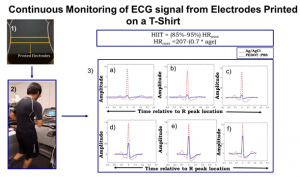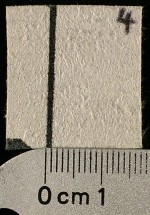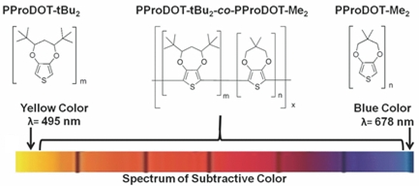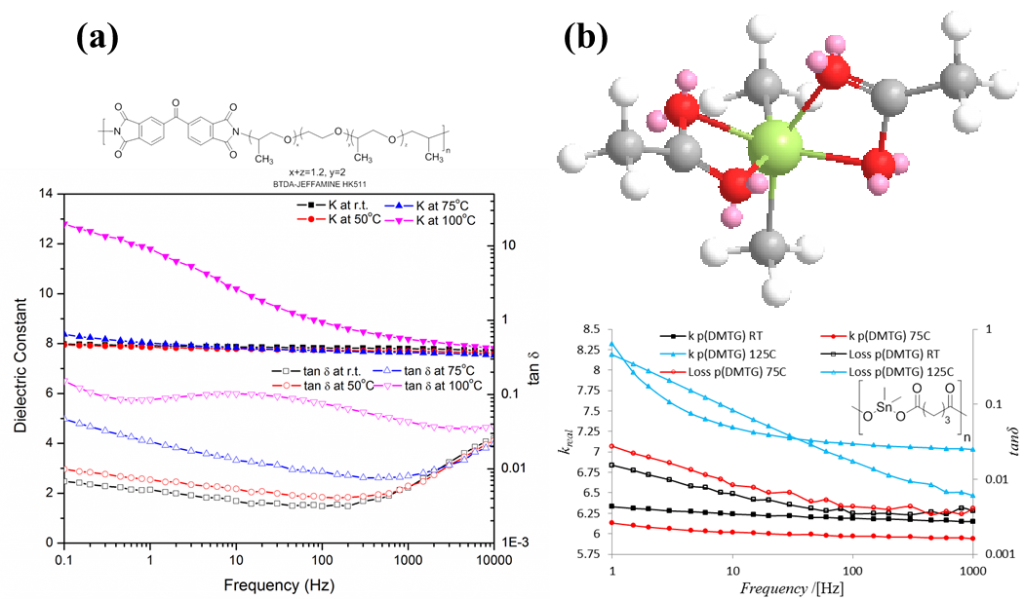New Area of Research: Cannabinoids
-
- Exploring the Drug aspects of cannabinoids: Anti-cancer, Osteoarthritis, and other.
- Antioxidant properties of the cannabinoid polymers for food packaging, anti- corrosive etc.
Three Main Areas of Conductive Polymer Research
Highly Conductive Polymers (Conductive Textiles)
|
Demonstration of an AC 120V Heatlamp being pushed over 2 Amps through synthetic leather treated with PEDOTPSS. |
Demonstration of a DC 20Watt lightbulb through synthetic leather treated with PEDOTPSS. |
Printed PEDOT: PSS as Biopotential Electrodes (In collaboration with Prof. Ki Chon, Biomedical Engineering (BME).
The figure below demonstrates the application of screen-printed electrodes on a commercially available finished textile for recording an electrocardiogram (ECG) in dry skin conditions. ECG signal which is characterized by amplitude was found to increase as a result of transpiration of water vapor from the skin during exercise. The maximum heart rate recorded here was 180 bpm. Applications of such electrodes can also be extended to measure electromyogram (EMG) and electroencephalogram (EEG).
Figure : 1)Screen Printed PEDOT:PSS electrodes on a commercially finished t-shirt, 2)Testing of printed t-shirt under exercise (running on a treadmill), 3)Electrocardiograms obtained at different intensities of exercise: 1) Rest 2) 2 mph 3) 3mph 4) 4mph 5) 5mph 6) Recovery mode -2mph
Copper Replacement
Our PEDOT:PSS treated synthetic leather has proven to be a viable copper replacement in both standard AC and DC circuits as shown in the videos above. The lowest resistance acheived so far is 0.447 Ohm/sq.
Patterned Lines "Organic Wires"
PEDOT:PSS has been demonstrated in lab to be patterned onto the surface of synthetic leather by several techniques. Precise control over dimensions is possible with the example image being 1 inch long and 1 millimeter wide with tight control of edge roughness. The PEDOT:PSS organic wire is able to carry up to 0.3 amps reliably with a sheet resistance down to 2 Ohm/sq.
Resistive Heating
The synthetic leather is an excellent choice of fabric for resistive heating and at low voltages (such as that of many small batteries), it can potentially sustain temperature for long periods of time. Using a power source of 5V and 1.15Amp and a treated leather sample with 2.2Ohms/sq sheet resistance, the leather was able to heat up to 200*C in 2 minutes and return to room temperature in 2 minutes. Additionally after soaking in water until saturation, the 5V power was applied and the leather sampled dried completely in 8 minutes.
Conductive Polymers (Electrochromics)
Demonstration of a large area electrochromic window with ProDot polymer.
Roughly 20cm by 10cm Electrochromic Display Switching Between Neutral and Oxidized States.
The above device is made using our patented one step in situ procedure to simplify fabrication in an open atmosphere, reduce assembly time, create less waste, and be amenable to high volume manufacturing.
Color Tuning
Our heterocyclic synthesis team develops new monomers and oligomers to perciscely tune the color of electrochromatic devices. For instance combining two monomers shown below, which give a yellow and blue color when oxidized, the resulting copolymer formed during in situ polymerization can be anywhere in the subtractive color spectrum for those two monomers.
Demonstration of Spandex switching color and while being stretched.
Color changing fabric is an active area of research in the Sotzing group. As shown above spandex treated with electrochromic polymer is able to switching even while stretched and still has the texture of spandex. Combined with PET treated with PEDOTPSS shown above the copper leads could be replaced to yield a completely polymer textile that changes color on demand.
Insulating Polymers (High Dielectric)
The Sotzing group is investigating advanced polymeric films with high dielectric and low loss properties in conjunction with a Multidisciplinary University Research Initiative (MURI) grant through the Office of Navel Research (ONR). The team includes specialization in computational and synthetic chemistry as well as polymer processing, the entire team can be seen on the collaborators page.Since the chemical space of new dielectric materials is so vast, our synthetic efforts are very collaborative with theoreticists to narrow the search area to a handful of promising, synthesizable candidates. As a result our research focus is split between traditional organic and more “exotic” organometallic polymers, shown in Figure 1.
Figure 1. Dielectric properties of (a) polyimide (BTDA/HK511) based on 3,3’,4,4’-benzophenone-tetracarboxylic dianhydride (BTDA) and Jeffamine HK511 and (b) poly(dimethyltin glutarate). The illustration at top right represents one octahedral complex that organotin polymers take.
Even though the research is split into two different types of materials there is much commonality between them. In both areas we focus on the synthesis of high functional group density polymers to increase the total polarization of the polymer backbone and drive the dielectric constant higher. Both of these offer higher dielectric constant and better thermal stability than the current gold standard Biaxially Oriented PolyPropylene (BOPP).



